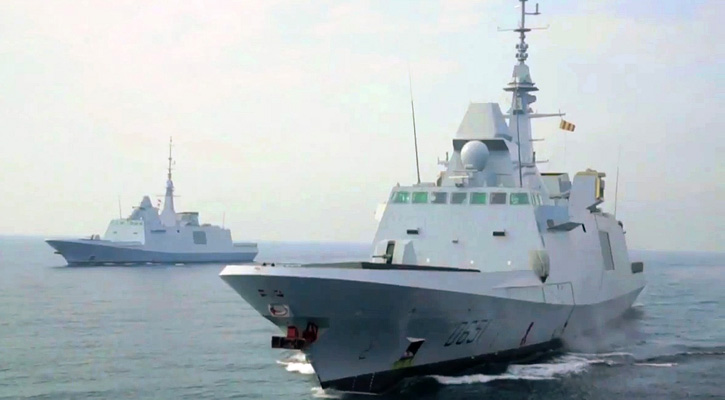Smart Weapons will not use GPS data
Navigation and guidance experts at the U.S. Defense Advanced Research Projects Agency (DARPA) in Arlington, Va., are trying to reduce the military’s reliance on Global Positioning System (GPS) satellite guidance for advanced munitions, mid- and long-range missiles, and other weapons by creating a navigation-system-on-a-chip that combines traditional and atomic inertial guidance technology.
DARPA released a broad agency announcement (DARPA-BAA-12-44) Monday for the Chip-Scale Combinatorial Atomic Navigator (C-SCAN) program, which seeks the co-integration of inertial navigation sensors with different kinds of physics on one micro-scale inertial measurement unit (IMU), which address challenges of long-term drift, dynamic range, and component start-up time.
Potential applications for these kinds of advanced navigational sensor chips are smart weapons, positioning, targeting, navigation, and guidance.
DARPA microelectronics researchers want to develop a integrated navigation chip that not only combines inertial sensors with dissimilar-yet-complementary physics into one system on a chip, but also does not rely on signals from GPS satellites.
Military reliance on GPS signals for precision positioning, navigation, and timing (PNT) information is crucial for a wide range of military weapons, DARPA officials point out. Yet when GPS is inaccessible due to component or system malfunction or enemy jamming, only on-board IMU technology can guide the weapon to its target.
DARPA wants industry to explore how shrink and fabricate atomic sensors together with high-performance solids-state inertial sensors. The chip should be no larger than 20 cubic centimeters and consume no more than one Watt of power.
DARPA experts say they plan to award several research contracts for the C-SCAN program, which is part of DARPA’s micro-PNT (microtechnology for positioning, navigation, and timing), the goal of which is to develop technologies for self-contained chip-scale inertial navigation and precision guidance that could eliminate the dependence on GPS or any other external signals for uncompromised navigation and guidance of military weapons.
Today’s state-of-the-art microscale inertial instruments can provide the precision necessary for missions for only 30 seconds or less, DARPA officials explain. The micro-PNT program is developing chip-scale, small size, weight, power, and cost, inertial sensors for missions ranging from minutes to hours.
Micro-PNT work revolves around chip-scale precision timing devices and inertial sensors, including chip-scale atomic clocks, chip-scale primary atomic clocks, solid-state oscillators, silicon accelerometers, vibratory rate gyroscopes, rate integrating gyroscopes, electrostatically levitated spinning mass gyroscopes, and micro nuclear magnetic resonance gyroscopes.
Despite micro-PNT work to date, challenges remain. Vibratory gyroscopes can achieve the required level of bandwidth and frequency of measurements, for example, but they have limited resolution and poor long-term stability. Atomic sensors have excellent resolution and bias stability, but are limited in bandwidth and generally do not allow high-frequency measurements.
The warm-up and integration times for different type of clocks and inertial sensors, moreover, also vary broadly, from seconds for mechanical vibratory devices to tens of minutes for atomic devices.
An IMU device for weapons guidance must warm-up period and reach its optimal readout characteristics quickly. The expected turn-on time of the Hellfire air-to-surface missile, for example, is about five seconds. Achieving 20 minutes of free inertial guidance is a major technological challenge.
For the C-SCAN program, DARPA scientists particularly are interested in technologies involving combinatorial chip-scale clock; cold-atom technology on the micro-scale; chip-scale nuclear magnetic resonance (NMR) gyroscopes; and IMU based on cold-atom interferometry.
Current versions of atomic inertial sensors suffer from several drawbacks, such as extremely long warm-up time (tens of minutes), long integration time to reach an optimal reading (thousands of seconds), and instrumentation that is very complex, bulky, and power hungry, DARPA officials say.
In contrast, solid-state inertial sensors are very compact (tens of cubic millimeters), with short warm-up times (seconds), fast integration times (seconds), and low power consumption (milliwatts). In addition, solid-state sensors can be instrumented with exceptional responsiveness, large bandwidth, and a broad dynamic range of operation. However, the major drawback of solid-state inertial sensors is the loss of long-term bias and scale-factor stability.
More information is online at https://www.fbo.gov/spg/ODA/DARPA/CMO/DARPA-BAA-12-44/listing.html.
http://www.militaryaerospace.com Posted by John Keller

